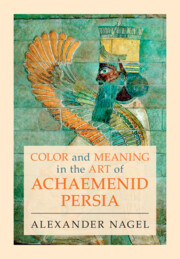Book contents
- Color and Meaning in the Art of Achaemenid Persia
- Color and Meaning in the Art of Achaemenid Persia
- Copyright page
- Contents
- Figures
- Acknowledgments
- Introduction: The Most Beautiful Blues
- Chapter One Defining Polychromies
- Chapter Two Historiographical Overview, Part I: Approaching Achaemenid Persian Polychromies in the Nineteenth Century – Ancient Literary Testimony and Modern Discourses
- Chapter Three Historiographical Overview, Part II: Approaching Achaemenid Persian Polychromies in the Twentieth Century
- Chapter Four Uncomfortable Truths: Challenges of Documenting and Preserving Achaemenid Persian Polychromies
- Chapter Five A Discussion: Aspects of Nonverbal Communication in the Achaemenid Persian Empire
- Chapter Six Concluding Contemplations
- Bibliography
- Index
Chapter Five - A Discussion: Aspects of Nonverbal Communication in the Achaemenid Persian Empire
Published online by Cambridge University Press: 24 August 2023
- Color and Meaning in the Art of Achaemenid Persia
- Color and Meaning in the Art of Achaemenid Persia
- Copyright page
- Contents
- Figures
- Acknowledgments
- Introduction: The Most Beautiful Blues
- Chapter One Defining Polychromies
- Chapter Two Historiographical Overview, Part I: Approaching Achaemenid Persian Polychromies in the Nineteenth Century – Ancient Literary Testimony and Modern Discourses
- Chapter Three Historiographical Overview, Part II: Approaching Achaemenid Persian Polychromies in the Twentieth Century
- Chapter Four Uncomfortable Truths: Challenges of Documenting and Preserving Achaemenid Persian Polychromies
- Chapter Five A Discussion: Aspects of Nonverbal Communication in the Achaemenid Persian Empire
- Chapter Six Concluding Contemplations
- Bibliography
- Index
Summary
In the preceding chapters, the focus has been on documenting traces of polychromy and on related matters of historiography, archaeology, and conservation. This chapter is an attempt to explain why knowledge of polychromy in the Achaemenid Persian Empire matters when studying Achaemenid Persian history. This chapter will show that systematic strategies for studying and analyzing pigments and polychromy in Persepolis and other heartland Achaemenid sites are not merely ends in themselves. Although important, they are not merely strategies of data development relevant to documentation in the practice of field archaeology and site conservation. The study of polychromy has the potential to greatly enhance our appreciation of the meanings of the Achaemenid visual vocabulary and culture. And because the Achaemenid Persian Empire was so vast and so interconnected with the cultures within and contiguous to it, analyses of Achaemenid polychromy are critical ultimately to our growing understanding of polychromy throughout the greater Mediterranean region. According to Diana Young, colors “animate things in a variety of ways, evoking space, emitting brilliance, endow[ing] things with an aura of energy and light.”1 Polychromy is, therefore, a key feature in concepts supporting an anthropology of luminosity, since the very material components of color are elements of the light source itself, while it is part of the Mineral Universe these palatial sites represented.2
- Type
- Chapter
- Information
- Color and Meaning in the Art of Achaemenid Persia , pp. 172 - 199Publisher: Cambridge University PressPrint publication year: 2023



